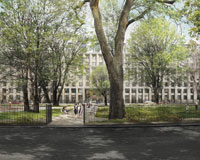 The owners of homes adjoining private garden squares across the capital could face the prospect of legal action over development to the rear of their properties following a high court ruling.
The owners of homes adjoining private garden squares across the capital could face the prospect of legal action over development to the rear of their properties following a high court ruling.
The decision by Supperstone J means that any development that is not completely subterranean could be regarded as unlawful under the London Squares Preservation Act 1931.
The judge rejected a challenge by the owner of 25 Collingham Road, a terrace adjoining private square Courtfield Gardens, to a decision by the Royal Borough of Kensington and Chelsea that it had no jurisdiction under the Act to approve works currently “well underway”, including creation of a rear lightwell extension.
The borough has indicated that it will seek an injunction to remove the works already carried out, and the judge said that he had been informed by its counsel that the case raised an “important point of legal principle for owners of properties adjoining squares throughout London”.
He added: “If the defendant is correct then not just the claimant but the owners of 15, 17, 21, 27, 31 and 33 Collingham Road (and other owners with properties adjoining squares elsewhere in London) all face the prospect that the development to the rear of their properties, which in a number of cases has been in place for many years, is now to be regarded as unlawful under the 1931 Act and hence liable to enforcement, including removal by injunction proceedings.”
One main issue in the case was whether the lightwell development being carried out qualified as “underground works”, which would fall within section 3(2) of the Act and could be capable of being permitted.
James Maurici QC argued on behalf of owner Eliterank that the underground lightwell development did not conflict with the statutory objective of maintaining the openness of garden squares, and so came within section 3(2) whether or not it was “open to the skies”.
However, ruling that it did not, the judge said: “In my view ‘underground’ in s.3 means below the surface of the ground. That accords with its ordinary English meaning as defined by the Oxford English Dictionary; and the definitions of it given in the Collins English Dictionary are not inconsistent with this interpretation. Indeed Collins gives ‘below the surface’ as a synonym for ‘below ground’. I reject Mr Maurici’s submission that works which are situated below the ground level of a protected square are underground works for the purposes of the 1931 Act, irrespective of whether they are, or are not, exposed to the sky.”
“In my judgment the surface use of the protected square by the claimant was not for or in relation to the construction and maintenance of underground works or buildings. None of the works (the courtyard, the lightwell, the bridge or the stairs) are underground works or buildings for the purposes of s.3(2) of the 1931 Act.”
Mr Maurici also argued that the borough failed to consider whether the steps fell within s.3(1) of the 1931 Act, which applies to structures for “the use and maintenance” of a square.
But he judge, dismissing that claim, said: “I do not accept that the bridge (with its stairs) is ‘convenient for… the use and maintenance of’ the square for an authorised purpose. In its application dated 14 May 2014 the purpose of the structure is stated to be ‘to enable the occupants to gain access to the gardens’. That has nothing to do with maintenance.”
Robert Barham, senior partner at Pemberton Greenish LLP, which was retained by the Courtfield Gardens West Garden Committee in the case, said that the decision is important for “all those interested in preserving the integrity of London’s garden squares”.
He said: “It shows that the 1931 Act cannot be ignored and it provides a viable weapon to fight unscrupulous neighbours and developers who would like to encroach on a protected garden.
“It will be interesting to see to what extent it will now be used against those who have already developed basements under communal gardens and whether they will now be forced to return land to its original use. Developers have been warned!”
R on the application of Eliterank Ltd v Royal Borough of Kensington & Chelsea Planning Court (Supperstone J) 10 February 2015
James Maurici QC (instructed by Messrs Stitt & Co) for the claimant
Timothy Straker QC and Dilpreet Dhanoa (instructed by Bi-Borough Legal Services (Hammersmith & Fulham and Kensington & Chelsea)) for the defendant







